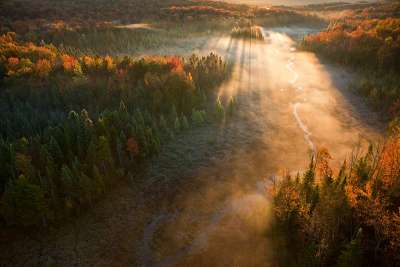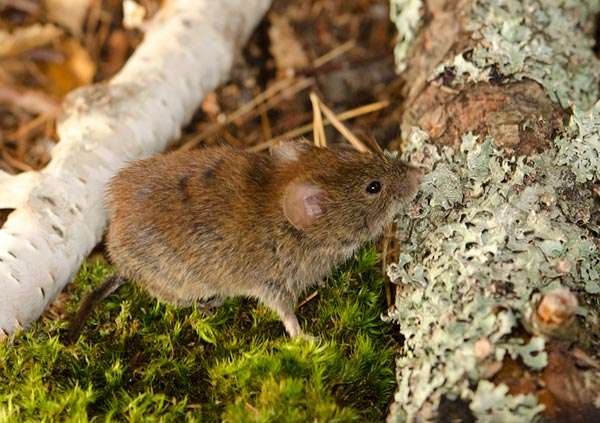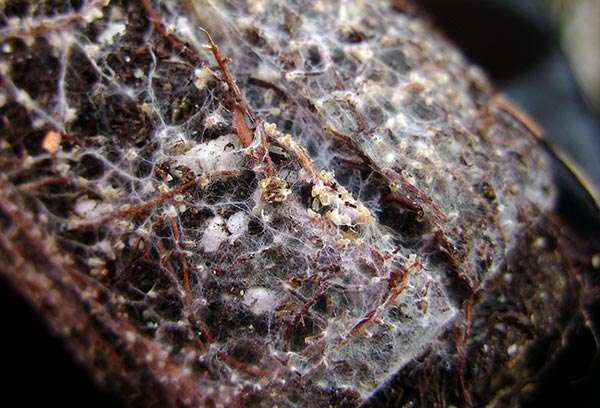Have you ever wondered why patch cuts in the North Woods become carpeted with spruce and fir seedlings within a few years of being cut, while beaver meadows in the same area stay grassy for decades, or even centuries? So have we, and so we were thrilled to come across John Pastor’s new book: What Should a Clever Moose Eat. In this passage Pastor, an ecologist and professor of biology at the University of Minnesota, sheds some light on the phenomenon.
The upland forests around beaver ponds are often composed of overstory aspen and understory spruce and balsam fir. These are quintessential North Woods tree species. The vertical structure of these forests is readily evident to anyone sitting in a canoe in a pond, especially this time of year, when the golden aspen crowns lie between the dark green of the conifers and the cerulean blue of the sky.
In the fall, just after the blue-winged teal begin to migrate, beavers cut the aspens and drag the small branches and twigs to their ponds for their winter food cache. The cut aspen trees sprout again from their roots, but moose sometimes browse them heavily for their high nutrient content, avoiding the spruce and fir because their needles are difficult to digest. Freed of competition from the aspens, the understory spruce and fir grow taller and become the overstory, all the while casting a dense shade and inhibiting aspen seedlings and root suckers from growing. Eventually, a dark wall of spruce and fir erects itself around the pond margin, especially around smaller ponds where beaver can cut the entire population of aspen. Bereft of their preferred food, the beavers seek greener aspen pastures elsewhere and abandon the pond.
Without the beavers there to repair it, the dam soon fails, and the pond begins to drain. Just as the aspens in the upland are replaced by conifers, the flooded pond is replaced by a wet meadow. As the dam deteriorates during the next several decades, the water table in the meadow gradually descends. Sedges and irises and then various grasses invade the meadow, forming a thick prairie-like cover.
But the conifers remain firmly in place on the edge of the meadow. Few, if any, conifer seedlings can be found in the meadow, even a few dozen feet from the growing dark wall of spruce and fir. The seedlings that do establish themselves last but a year or two and then expire, while inside the forest, conifer seedlings sprout and grow into saplings and eventually mature, cone-bearing trees.
Why do all conifer seedlings die within a year or two in the meadow but survive and grow into saplings in the adjacent forest? It cannot be competition between the conifer seedlings and the dense grasses, because balsam fir and spruce readily invade powerline right-of-ways and roadsides, which also usually have a dense grass cover. It cannot be that the soil in the meadow is too wet for balsam fir and spruce, as they can grow in peatlands that are often wetter than the drained meadows.
More than half a century ago, Sergei Wilde, a soil researcher at the University of Wisconsin, suggested that conifers could not invade beaver meadows because the meadow soils lack a suite of fungi known as mycorrhizae. In other settings, these fungi, whose species number in the thousands, form a tight symbiosis with plant roots, interpenetrating the root tissues. The fungal mycelium extends the root network farther into the soil. The fungi receive carbohydrates from the tree, and in turn supply the tree with additional nutrients such as nitrogen and phosphorus, which the very fine and root-like fungal hyphae take up from the soil. This carbohydrate-for-nutrient swap between the mycorrhizal fungus and the tree sustains both the host tree and the fungus for the lifetime of the tree. Some fungal species form associations only with specific tree species, whereas others associate with a broad range of host tree species. Most trees have associations with many different fungal species. Without this symbiosis with mycorrhizal fungi, most seedlings in beaver meadows die within a year or two.
Wilde found that the mycorrhizal fungi in the meadow are killed during the long period of time that the beavers actively maintain the dam and flood the soil behind it. He proposed that when the pond is abandoned and then drains, spruce and fir seedlings cannot immediately grow in the soil in the meadow because the soil is bereft of mycorrhizal fungi.
But as with all good problems in natural history, answering one question only raises more. Obviously, there must be mycorrhizal fungi in the forest immediately adjacent to the meadow because spruce and fir seedlings grow quite well there. If this is the case, why don’t these fungi reinvade the meadow even after a few decades of the meadow being drained? Shouldn’t the spores produced by their fruiting bodies have dispersed?
The answer to this question involves another symbiotic relationship – this one between fungi and the red-backed vole. Many mycorrhizal fungal species have their fruiting bodies below ground, and the voles burrow in the soil, find the fruiting bodies, consume them, and void the spores in their fecal pellets.
In a study of the diversity of mycorrhizal spores in red-backed vole fecal pellets in Minnesota’s North Woods, we identified 15 different species of fungi.
Documenting the broad diversity of mycorrhizal spores in vole fecal pellets answers one question but prompts several others: Are these spores capable of forming symbioses with spruce or fir seedlings after passage through the vole’s digestive system? If we inoculate beaver meadow soil with vole fecal pellets containing these spores, will spruce seedlings then be able to grow? Answering these questions was the objective of a thesis of John Terwilliger, one of my graduate students.
To do his experiments, John needed a source of both spruce seedlings and red-backed vole fecal pellets. The first was easy: He obtained seeds from the Minnesota Department of Natural Resources and germinated them in sterilized potting soil (the soil had to be sterilized to ensure that he began with seedlings without any mycorrhizae). Red-backed vole fecal pellets are not available from any scientific supply company, so he went into the woods and caught the voles nightly with live traps. Voles have the convenient habit of voiding when they are first trapped, so every morning John collected the fecal pellets and, after marking the vole to determine population density, released it. The vole scurried away, probably a bit perplexed but unharmed. John then put out a clean trap for the next night until he had an adequate supply of vole fecal pellets, perhaps the largest supply of vole feces anyone has ever collected then or since. He trapped voles in both May (early spring here in northern Minnesota) and August (the end of summer) to see whether there was any difference in the amount and types of fungi in the voles’ diet during the growing season.
Next, he examined the fecal pellets for spores of mycorrhizal fungi and found many of the same spores that we had found previously. He then collected soils from three beaver meadows and three adjacent forests and assigned subsamples from each of them into one of four groups: meadow soils inoculated with fecal pellets collected in May, meadow soils inoculated with fecal pellets collected in August, meadow soils that remained uninoculated to serve as a control, and the forest soils. He then grew the spruce seedlings in small pots in soils from each of the four groups in a greenhouse.
John harvested some of the spruce seedlings after 12 weeks and the rest after 48 weeks, weighed and dissected them into roots and shoots, and examined their roots for mycorrhizal fungi hyphae, which are easily seen under a dissecting microscope. The results of this experiment were the sort of conclusive results we all hope for but rarely get. None of the seedlings in beaver meadow soil without vole fecal pellets had any mycorrhizae. These promptly died. In contrast, 93 percent of the seedlings grown in forest soil collected in May and 100 percent of the seedlings grown in forest soil collected in August had formed symbioses with mycorrhizae. Almost all of them survived. What’s more, about 30 percent of the seedlings grown in meadow soils inoculated with vole fecal pellets formed symbioses with mycorrhizae and survived. Clearly, forest soils contain sufficient mycorrhizal spores to inoculate spruce seedlings, and meadow soils contain none, but adding vole fecal pellets to meadow soils provided a source of mycorrhizae to the seedlings. In addition, seedlings grown in forest soils weighed twice as much as those grown in meadow soils without fecal pellets, and the seedlings grown in meadow soils with fecal pellets weighed somewhere in between. The soils inoculated with August pellets produced larger seedlings than those inoculated with May pellets, possibly because the fungi had an entire growing season to produce fruiting bodies.
The fecal pellets could also add nutrients to the soil, and we had previously found that pellets rapidly release their nitrogen and phosphorus upon decay. Thus, fecal pellets could also benefit the seedlings by acting as a fertilizer. But the amount of nitrogen and phosphorus in the pellets was much, much less than that needed to support the growth of seedlings. So the evidence is in favor of pellets aiding seedling growth mainly by supplying mycorrhizal fungi rather than by supplying nutrients.
Besides the differences in seedling growth between the groups, there were also interesting trends in the allocation of seedling growth to roots (to obtain water and nutrients from the soil) and shoots (to capture light to drive photosynthesis). Bereft of any mycorrhizal fungi to extend their root system with hyphae, the spruce seedlings grown in the uninoculated meadow soils had to produce more of their own roots compared with seedlings grown in the forest soil or the inoculated meadow soil. But the seedlings in uninoculated meadow soil were also smaller than those that formed associations with mycorrhizae in the forest and inoculated meadow soils. These differences in seedling growth indicate that it is more effective for a seedling to supply carbohydrates to mycorrhizal fungi to produce hyphae than to produce its own roots to capture nutrients.
But don’t the red-backed voles travel from the forest into the meadow? To answer this question, John placed live traps in the beaver meadows adjacent to the forests where he captured the red-backed voles for his supply of fecal pellets. He caught only one, and it was on a small island in the middle of the meadow on which eight black spruce trees grew. Clearly, red-backed voles stay out of beaver meadows, and so the mycorrhizal fungi population that was killed when beavers flooded the pond could not be reestablished through dispersal by the red-backed voles.
So why don’t red-backed voles go out into beaver meadows? Perhaps the dense grasses are not to their liking. Red-backed voles seem to prefer forests with an abundance of down logs, whose lower sides provide cover from owls and whose tops serve as runways, instead of grassy meadows without logs. But there may be a more interesting reason. The rodent John caught most often in the beaver meadows was, appropriately enough, the meadow vole, which he never caught in the forest. Meadow voles and red-backed voles are aggressive against each other and each can exclude the other from its respective preferred habitats. Wars fought between these two species of vole at the boundary between forest and meadow might prevent red-backed voles from entering the meadows even if they were inclined to do so.
The obvious next experiment would be to fence and enclose a large area of meadow extending partly into the adjacent forest and trap and remove all meadow voles inside. Then, the end in the forest would be opened so that red-backed voles could enter it. If the aggression by the meadow voles is the factor keeping red-backed voles out of the meadow, then eventually we should begin to trap red-backed voles inside the enclosure once meadow voles are removed. Given enough time for the red-backed voles to inoculate the meadow soil with fecal pellets, spruce or fir seedlings should become established in the enclosure. We have not done this experiment, but here it is, an open invitation for an enterprising graduate student with fence-building skills. Science is not always done by expensive and complicated technology such as DNA sequencers and particle accelerators. Sometimes a simple fence and a few live traps are enough.





Discussion *